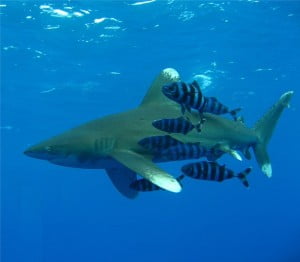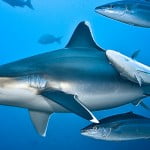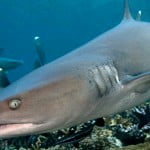The oceanic whitetip shark, Carcharhinus longimanus, is a large pelagic shark inhabiting tropical and warm temperate seas. Its stocky body is most notable for its long, white-tipped, rounded fins.
This aggressive but slow-moving fish dominates feeding frenzies, and is a danger to shipwreck or air crash survivors.[1] Recent studies show steeply declining populations because its large fins are highly valued as the chief ingredient of shark fin soup and, as with other shark species, the whitetip faces mounting fishing pressure throughout its range.
Distribution and habitat
 The oceanic whitetip is found globally in deep, open water, with a temperature greater than 18 °C(64 °F).[7] It prefers waters between 20 °C (68 °F) and 28 °C (82 °F) and tends to withdraw from areas when temperatures fall outside of this.[6] They were once extremely common and widely distributed, and still inhabit a wide band around the globe; however, recent studies suggest that their numbers have drastically declined.[2] An analysis of the US pelagic longline logbook data between 1992–2000 (covering the Northwest and Western Central Atlantic) estimated a decline of 70% over that period.[3]
The oceanic whitetip is found globally in deep, open water, with a temperature greater than 18 °C(64 °F).[7] It prefers waters between 20 °C (68 °F) and 28 °C (82 °F) and tends to withdraw from areas when temperatures fall outside of this.[6] They were once extremely common and widely distributed, and still inhabit a wide band around the globe; however, recent studies suggest that their numbers have drastically declined.[2] An analysis of the US pelagic longline logbook data between 1992–2000 (covering the Northwest and Western Central Atlantic) estimated a decline of 70% over that period.[3]
They are found worldwide between 45° north and 43° south latitude.[4][7] In 2004, an oceanic whitetip was discovered dead on the west coast of Sweden—far beyond what was once considered the northern boundary of its range.[8]
The shark spends most of its time in the upper layer of the ocean—to a depth of 150 metres (490 ft)[7]—and prefers off-shore, deep-ocean areas. According to longline capture data, increasing distance from land correlates to a greater population of sharks.[5] Occasionally it is found close to land, in waters as shallow as 37 metres (120 ft), mainly around mid-ocean islands such as Hawaii, or in areas where the continental shelf is narrow and there is access to nearby deep water. It is typically solitary, though gatherings have been observed where food is plentiful.[6] Unlike many animals, it does not have a diurnal cycle, and is active both day and night.[5] Its swimming style is slow, with widely spread pectoral fins. Despite their habitual isolation from members of their own species, pilot fish, dolphinfish, and remora may accompany them.[5] In 1988, Jeremy Stafford-Deitsch reported seeing an individual accompanied by a shortfin pilot whale.[9]
Anatomy and appearance
C. longimanus’ most distinguishing characteristics are its long, wing-like pectoral and dorsal fins. The fins are significantly larger than most other shark species, and are conspicuously rounded. The shark’s nose is rounded and its eyes are circular, with nictitating membranes.[5]
C. longimanus has a ‘typical’, although somewhat flattened requiem shark body, often with a mildly humpbacked aspect. It is bronze, brown, bluish or grey dorsally (the color varies by region), and white ventrally (although it may occasionally have a yellow tint). Its maximum size is 4 metres (13 ft), although usually it does not exceed 3 metres (10 ft). Its maximum reported weight is 170 kilograms (370 lb). The female is typically larger than the male by 10 centimetres (4 in) with males about 1.8 metres (71 in) and females about 1.9 metres (75 in).[5][6]
Most of its fins (dorsal, pectoral, pelvic, and caudal) have white tips (juvenile specimens and some adults may lack these). Along with white tips, the fins may be mottled—and in young specimens can have black marks. A saddle-like marking may be apparent between first and second dorsal fins.[5] The shark has several kinds of teeth—those in the mandible (lower jaw) have a thin serrated tip and are relatively small and triangular (somewhat fang-like). There are between 13 and 15 teeth on either side of the symphysis. The teeth in the upper jaw are triangular, but much larger and broader with entirely serrated edges—there are 14 or 15 along each side of the symphysis.[5] The denticles lie flat and typically have between five and seven ridges.[5]
Diet
C. longimanus feeds mainly on pelagic cephalopods and bony fish.[7] However, its diet can be far more varied and less selective—it is known to eat threadfins, stingrays, sea turtles, birds, gastropods, crustaceans, and mammalian carrion. The bony fish it feeds on include lancetfish, oarfish,barracuda, jacks, dolphinfish, marlin, tuna, and mackerel. Its feeding methods include biting into groups of fish and swimming through schools of tuna with an open mouth. When feeding with other species, it becomes aggressive.[6] Peter Benchley, author of Jaws, observed this shark swimming among pilot whales and eating their feces.[10]
Behavior
The oceanic whitetip is usually solitary and slow-moving, and tends to cruise near the top of the water column, covering vast stretches of empty water scanning for possible food sources.[5] Until the 16th century,[11] sharks were known to mariners as “sea dogs”[12] and the oceanic whitetip, the most common ship-following shark,[6] exhibits dog-like behavior when its interest is piqued: when attracted to something that appears to be food, its movements become more avid and it will approach cautiously but stubbornly, retreating and maintaining a safe distance if driven off, but ready to rush in if the opportunity presents itself. Oceanic whitetips are not fast swimmers, but they are capable of surprising bursts of speed. Whitetips commonly compete for food with silky sharks, making up for its comparatively leisurely swimming style with aggressive displays.[6]
Groups often form when individuals converge on a food source, whereupon a feeding frenzy may occur. This seems to be triggered not by blood in the water or by bloodlust, but by the species’ highly strung and goal-directed nature (conserving energy between infrequent feeding opportunities when it is not slowly plying the open ocean). The oceanic whitetip is a competitive, opportunistic predator that exploits the resource at hand, rather than avoiding trouble in favor of a possibly easier future meal.[6]
There does not seem to be segregation by sex and size. Whitetips follow schools of tuna or squid, and trail groups of cetaceans such as dolphins and pilot whales, scavenging their prey. Their instinct to follow is so strongly imprinted, from countless millennia following baitfish migrations, that they accompany ocean-going ships. When whaling took place in warm waters, oceanic whitetips were often responsible for much of the damage to floating carcasses.[6]
Reproduction
Mating season is in early summer in the northwest Atlantic Ocean and southwest Indian Ocean, although females captured in the Pacific have been found with embryos year round, suggesting a longer mating season there.[6] The shark is viviparous—embryos develop in utero and are fed by a placental sac. Its gestation period is one year. Litter sizes vary from one to 15 with the young born at a length of about 0.6 metres (24 in).[3]Sexual maturity is reached at close to 1.75 metres (69 in) for males and 2 metres (80 in) for females.
















